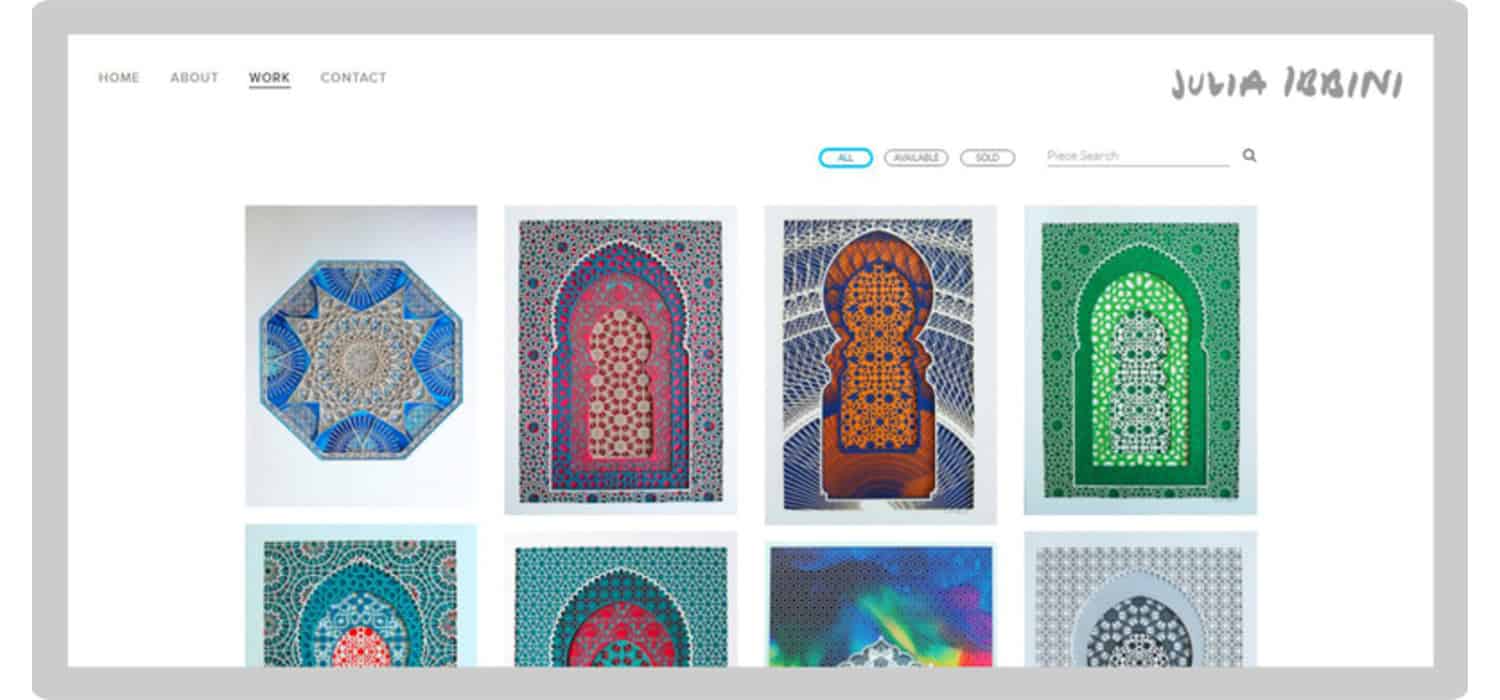Are you an artist looking to showcase your work to the world? Creating an online art portfolio is essential. It’s not just about displaying your creations; it’s about opening doors to opportunities and connections. This guide will help you choose the perfect platform to reflect your unique style and artistic needs.
How to Make an Online Portfolio for Art: Select a platform like Squarespace or Wix that aligns with your style. Customize your portfolio, upload your best work, and optimize for easy navigation.
Don’t stop here! Learn more about the specific features that make each platform ideal for artists. Make your portfolio stand out from the crowd. Keep reading to find out how!
Choosing the Right Platform
When setting up your online art portfolio, the first step is choosing the right platform. The best choice can enhance your artwork’s visibility and accessibility.
Why Use Website Builders?
Platforms like Squarespace and Wix offer user-friendly interfaces and stunning design templates. Website builders make it easier to create a professional-looking portfolio without needing advanced coding skills. They also provide robust Adobe Solutions to refine visuals and layouts, ensuring your art stands out.
Tailoring to Your Artistic Style
It’s crucial to pick a platform that resonates with your artistic sensibility. Each builder offers unique features that might suit different types of art, from digital works to classic paintings. According to Website Builder Expert, considering how these features align with your work will ensure your portfolio not only looks great but feels right.
Benefits of Choosing Wisely
A well-chosen platform empowers you to effectively manage and showcase your art. It can handle high-resolution images smoothly, offer excellent uptime, and ensure your site remains responsive across all devices. More importantly, the right platform can help attract galleries, collectors, and commissions by providing a professional and cohesive online presence.
Your choice of platform sets the foundation of your online portfolio. It’s about finding the right balance between aesthetics, functionality, and ease of use. By focusing on these aspects, you’re well on your way to creating an online space that truly represents your artistic vision and attracts the right audience.
Designing a Compelling Homepage
Your homepage is often the first impression visitors have of your online art portfolio. It sets the tone for your entire site and can significantly influence a visitor’s decision to explore further.
Eye-Catching Banner
Start with an eye-catching banner. This feature acts as the centerpiece of your homepage. Select a banner image that encapsulates your art style or features one of your standout pieces. This visual appeal can instantly engage visitors, drawing them into your portfolio.
Artist Statement
Directly below your banner, include your artist statement. This should be concise yet powerful, offering insight into your artistic journey, inspirations, and what you hope to communicate through your art. It’s your chance to make a personal connection with viewers, which can be especially compelling for potential buyers or galleries.
Easy-to-Navigate Menu
An easy-to-navigate menu is crucial. Tools like Wix offer various customizable menu designs that are both beautiful and functional. Ensure that your menu is intuitive, with categories clearly labeled and logically organized. Common sections include galleries, about the artist, contact information, and possibly a blog or a section for upcoming events.
Additional Homepage Features
To further enhance your homepage, consider including:
- A newsletter signup prompt to keep visitors informed.
- Links to social media to extend your reach and engagement.
- A short introduction or welcome video that provides a quick overview of your art and personality.
A compelling homepage effectively combines aesthetics with usability. By focusing on a striking banner, a personal artist statement, and an easy-to-navigate menu, you create an inviting and informative first point of contact with your audience. These elements help ensure that visitors not only stay longer on your site but also return frequently.
Showcasing Your Artwork
Presenting your artwork effectively online is crucial for capturing and maintaining the interest of visitors to your art portfolio. Here’s how to categorize and display your pieces in the most engaging way possible.
Effective Categorization
Start by organizing your artwork into clear, easy-to-understand categories. This could be by medium (e.g., paintings, sculptures), style (abstract, realism), or theme (nature, urban). Effective categorization helps visitors find the type of art they are interested in more quickly and enhances their overall experience on your site.
Using High-Quality Images
One of the most important aspects of showcasing your art online is using high-quality images. Ensure that each piece is photographed in good lighting without any glare or shadows that could obscure the details. High-resolution images allow viewers to appreciate the finer details of your work, which can be critical in conveying the texture and technique used.
Detailed Descriptions
Next to each artwork, provide a detailed description. This should include not only the title, medium, and size but also a brief story about what inspired you or what you intend to convey through the piece. This adds a layer of depth that can resonate emotionally with viewers.
Tips for Presenting Artworks Effectively
- Consistent Style: Keep the style of your images consistent. Use the same background for photographs to maintain a professional and cohesive look across your portfolio.
- Zoom Features: Platforms like Wix allow you to incorporate zoom features so visitors can see close-up details of your work.
- Virtual Galleries: Consider creating virtual gallery tours on your website, which can provide a more immersive experience for visitors.
Interactive Elements
Engage your audience further by adding interactive elements. For example, include videos of you creating your art or discussing your process. This kind of content can make your website not just a place to view art but a venue to experience your creative journey.
Effectively showcasing your artwork online involves more than just uploading images. It requires thoughtful categorization, the use of high-quality images, and detailed descriptions that bring your artwork to life. By following these tips, you ensure that your online portfolio not only displays your work in the best light but also tells the story of your art in a compelling and engaging way.
Personal Branding and Aesthetic
In the world of art, personal branding and aesthetic consistency are key to setting yourself apart. Your online portfolio is not just a collection of works; it’s a representation of your artistic identity.
Consistency in Design and Layout
Maintaining consistency in your website’s design and layout helps create a professional and recognizable brand. This means using the same fonts, formatting styles, and layout structures across all pages. Consistency makes your site easier to navigate and reinforces your brand’s visual identity, enhancing the overall user experience.
Choosing a Color Palette
Selecting the right color palette is crucial. It should reflect your artistic style and complement your artwork. According to Website Builder Expert, choosing a color scheme that harmonizes with your art can enhance visual impact and make your portfolio memorable. Consider colors that appear frequently in your work or shades that evoke the emotions you wish to convey.
Implementing Your Brand
- Logo and Favicon: Design a simple yet striking logo that appears on all pages and tabs. This increases brand recall.
- Custom Icons: Use custom icons that match your color palette for a cohesive design theme.
- Typography: Choose typography that reflects your artistic personality, whether it’s elegant, bold, or whimsical.
Your personal branding and aesthetic play a crucial role in how your art is perceived. By focusing on consistency in design and a thoughtful color palette, you not only enhance the visual appeal of your portfolio but also ensure it authentically represents your unique artistic voice.
Updating and Curating Content
A dynamic online art portfolio is key to attracting and retaining interest. Regular updates and careful curation are essential strategies to keep your portfolio fresh and engaging.
Keeping Your Portfolio Fresh
Consistently adding new artworks is crucial. It shows that you are active and evolving in your artistic pursuits. According to OCAD, regularly updating your portfolio with new pieces can capture the attention of repeat visitors and improve your visibility in search engines. However, it’s equally important to remove older or less representative works to maintain a high-quality and relevant collection.
The Balance Between Quality and Quantity
While it’s tempting to display a large number of works to demonstrate versatility and productivity, the balance between quality and quantity must be maintained. Focus on showcasing your best pieces that accurately represent your skills and artistic vision. This ensures that your portfolio remains impressive and cohesive, rather than overwhelming and diluted.
Strategies for Effective Curation
- Seasonal Updates: Consider updating your portfolio seasonally to keep the content fresh and relevant.
- Highlight Recent Works: Feature your most recent or notable pieces prominently to catch immediate attention.
- Archives: Create an archive section for older works that hold sentimental value or show your progression. This allows interested viewers to explore your journey without cluttering the main portfolio.
Updating and curating your online art portfolio are critical to its success. By strategically balancing the introduction of new pieces and the removal of outdated ones, and by focusing on the quality of displayed works, you ensure that your portfolio effectively represents your current artistic capabilities and style. This thoughtful approach not only enhances the aesthetic appeal of your portfolio but also reinforces your professional image in the art world.
User Experience and Accessibility
Ensuring an excellent user experience and accessibility is fundamental for the success of your online art portfolio. This not only helps in retaining visitors but also in expanding your audience reach.
Mobile-Responsive Design
In today’s digital age, a mobile-responsive design is not optional—it’s essential. With more people accessing websites from their smartphones and tablets, your portfolio needs to look good and function well on all devices. A mobile-responsive website automatically adjusts to the screen size and orientation of the device being used, which enhances usability and viewer satisfaction.
Functionality and Up-to-Date Links
Keeping all links and functions up-to-date is crucial for maintaining a professional online presence. According to OCAD, broken links or outdated functions can frustrate users and detract from their overall experience of your site. Regularly check and update your portfolio to ensure that everything works as intended, from navigation links to image loading and contact forms.
Implementing Accessibility Features
- Alt Text for Images: Include descriptive alt text for images. This not only aids visually impaired users but also helps search engines understand and index your artwork better.
- Keyboard Navigation: Ensure your website can be navigated using a keyboard alone, which is beneficial for users with certain disabilities.
- Contrast and Fonts: Use high-contrast color schemes and legible fonts to make your website easier to read for everyone, including those with visual impairments.
By prioritizing a mobile-responsive design and ensuring all website functions are current and working, you enhance the user experience and accessibility of your online art portfolio. These elements are key to making your website welcoming and easy to use for a diverse audience, thereby broadening your reach and impact in the art community.
Promoting Your Portfolio
Effectively promoting your online art portfolio is crucial for gaining visibility and attracting a wider audience. Leveraging social media, blogs, and email marketing are powerful tools to drive traffic to your site.
Social Media Engagement
Utilize platforms like Instagram, Facebook, and Pinterest to showcase your artwork and direct followers to your portfolio. These platforms are visually oriented, making them ideal for artists. Regular posts, behind-the-scenes content, and interactive sessions like live painting can engage your audience and encourage them to visit your website.
Blogging About Your Art
Maintaining a blog on your portfolio site can also attract visitors. Write about your creative process, the stories behind your artworks, or tips for other artists. According to Artwork Archive, blogs not only help in improving your site’s SEO but also establish you as a knowledgeable figure in the art community.
Email Marketing
Build an email list from your portfolio visitors by offering a subscription option. Send regular newsletters featuring new artwork, upcoming exhibitions, or exclusive content. Email marketing keeps your audience engaged over time and drives repeated traffic to your site.
Strategies for Effective Promotion
- Cross-Promotion: Share your blog posts on social media and include social links in your emails to create a cohesive marketing network.
- Engaging Content: Whether it’s a post, blog, or email, make sure your content is engaging and provides value to your audience. This encourages sharing and return visits.
By integrating social media, blogs, and email marketing into your promotion strategy, you can significantly enhance the reach and visibility of your online art portfolio. These tools not only help in attracting new visitors but also in building a loyal community around your art.
Conclusion
Setting up and maintaining an engaging online art portfolio is crucial for showcasing your art and expanding your reach. Choose the right platform, ensure your site is user-friendly, keep your content updated, and actively promote your portfolio. Share your experiences and tips in the comments below or on social media!
FAQ Section
What is the best platform to create an online art portfolio?
Platforms like Squarespace and Wix are top choices due to their user-friendly design tools, customizability, and excellent visual appeal for showcasing art.
How often should I update my online art portfolio?
Update your portfolio regularly, at least once a season, to keep it fresh and engaging for returning visitors and potential clients.
What makes a good art portfolio website?
A good art portfolio website features high-quality images, clear categorization, a mobile-responsive design, and up-to-date content that reflects your current artistic style and achievements.
How do I promote my online art portfolio?
Promote your portfolio using social media, blogging, and email marketing to drive traffic and engage a wider audience.
Can I sell art directly from my online portfolio?
Yes, integrating e-commerce functionality into your portfolio allows you to sell art directly to collectors, enhancing the monetization of your artistic work.

I am Sammy and I blog at Live it. Love it. Make it. It is creative lifestyle blog run by best friends H and Sammy. Head over and follow our crafty adventures!






